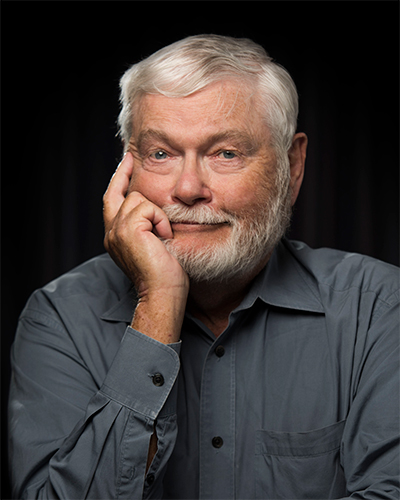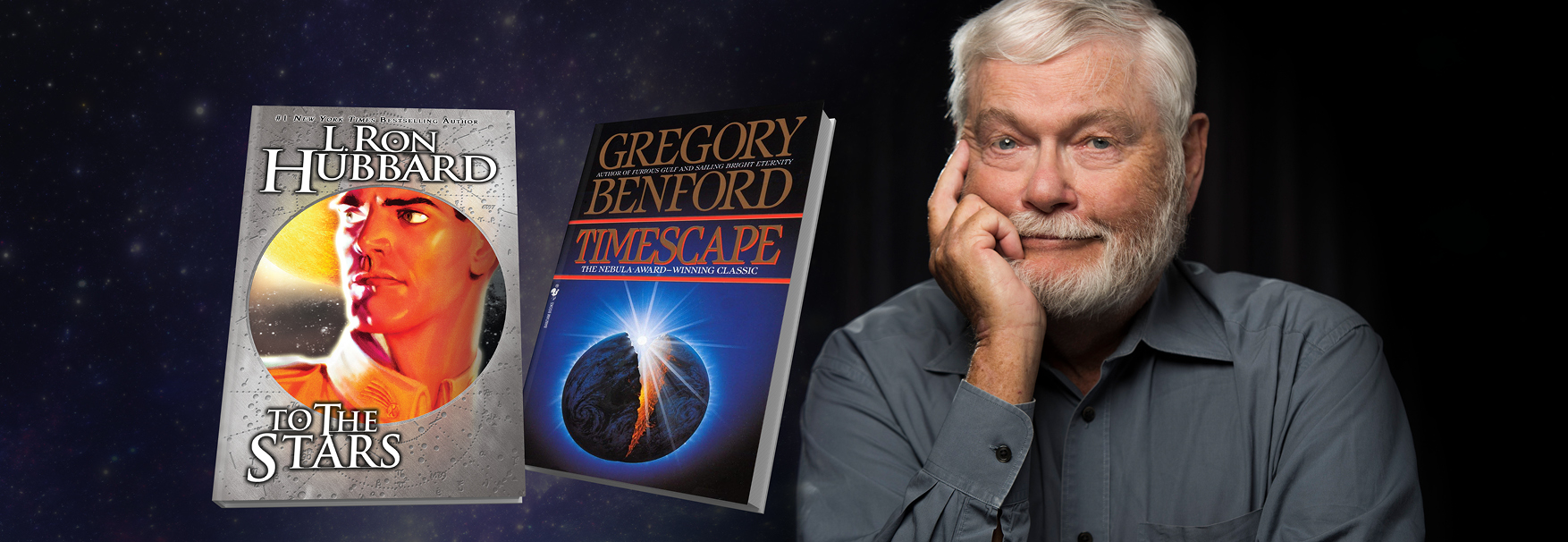Dr. Gregory Benford On To the Stars
To the Stars by L. Ron Hubbard was first published in two parts in Astounding Science Fiction in February and March 1950. As we mark the 75th anniversary of this seminal work in 2025, its influence on science fiction remains profound. In this article, Dr. Gregory Benford offers a fascinating view of the novel, examining its use of Einstein’s theory of relativity and its enduring impact on the field of science fiction. With his extensive background in science and speculative fiction, Benford uniquely assesses the scientific accuracy and portrayal of human space exploration in To the Stars. For more about Dr. Benford, see the bio in the article below.
On To the Stars
by Dr. Gregory Benford
I read this remarkable novel when I was but a kid, somewhere in the early 1950s. As its last line proclaims, it is a tale of high drama about being “outward bound on a mission to the ageless stars.”
It was very popular. “Remarkably ruthless” the SF Encyclopedia found it, and a rich lode of ideas.
Writers had used Einstein’s special relativity theory before in stories, but Hubbard brought to his novel the compressed storytelling and pulp skills that had stood him in over a decade of professional writing. There are no indigestible expository lumps, no pages of digressions. The story moves.
Not that he didn’t know the physics. He had studied modern physics and particularly relativity. A lot of writers have taken these ideas further in the over half a century since. For further turns you might read with pleasure James Blish’s “Common Time” (1953), Robert A. Heinlein’s Time for the Stars (1956), Joe Haldeman’s The Forever War (1975) and a spectacular use of the basic physics in Poul Anderson’s 1970 Tau Zero. Nobody can accuse us of thinking small.…
Or sloppily, either. Hubbard goes the final lap in actually writing out the relativistic equations for the increase of mass and slowing of time as a starship approaches the velocity of light, c. This is almost a talisman now in our field—a signature of a writer who wants to impart to the non-technical reader some of the iconic value of the mathematics, while letting the scientifically savvy know that the game is being played with the net fully up, and indeed, stretched tight.
This is an extravagant yarn. It poses characters trapped not just by the confines of their ship, but by the very laws of the cosmos. To voyage to high velocities, approaching light, is to strip us of our moorings in the past. Fast travel leaves behind not merely our origins, but our culture.
Immigrants often leave their homes knowing that they will probably never see them again—an experience very common in the 16th to the 20th century. But to know that those lands and cultures had vanished forever into the dark abyss of lost time—that is a cruelty visited by the laws of physics upon any intelligence, with no reprieve.
It is indeed the stuff of high drama. Of course Hubbard was drawn to it—not only in this work, but also in the earlier “Beyond All Weapons.”
For time is the most twisted idea in modern physics, with many nooks and crannies for a novelist. I wrote my novel Timescape about the implications of both special relativity and the more profound general relativity, on our basic understanding of time. There is plenty yet to do, too.
Time … and the stars. I have spent a lot of my professional life as a physics professor trying to work around the consequences of Einstein’s special theory of relativity. Over the last few years I’ve worked on both theory and experiment for ways to approach the relativistic realm. It seems that, unless you want to spend the budget of a major nation on a huge fuel-burning starship, you must ask for help.
Rather than Hubbard’s thundering spaceships, perhaps the next stage in our reach toward the stars will come from gossamer craft, driven by the weightless authority of light itself. With others, I’ve worked out ways that sails of thin fabrics could dive close to the sun, picking up big velocities by skirting close to the stellar fire. The increased sunlight there could propel such advanced sail craft—made of nearly pure carbon fibers, to survive the heat—to very high speeds.
It is within the realm of chemical rockets to give us speeds of 10 kilometers/second. Advanced nuclear can approach 100 kilometers/second. But a sundiver could perhaps attain 1,000 kilometers/second.
This seems pretty puny compared with light, which moves at 300,000 kilometers/second without breaking a sweat. But it’s a beginning.
If mankind ever reaches the stars, it will voyage on vessels we probably cannot imagine, using technologies we cannot glimpse. But those who go will be human. They will feel the pain and joy we ourselves know.
To the Stars shows us what that could be like. The physics gives it backbone, but the drama gives it heart.
 Dr. Gregory Benford is a physicist, educator, and author. He received a BS from the University of Oklahoma and a PhD from the University of California, San Diego. Benford is a professor of physics at the University of California, Irvine, where he has been a faculty member since 1971. He is a Woodrow Wilson Fellow and a Visiting Fellow at Cambridge University. He has served as an adviser to the Department of Energy, NASA, and the White House council on Space Policy. He is the author of over thirty-five novels, short story collections, nonfiction books, including In the Ocean of Night, Foundation’s Fear, The Berlin Project, Heart of the Comet (with David Brin), Bowl of Heaven (with Larry Niven), and Timescape for which he won the United Nations Medal in Literature in 1990. A two-time winner of the Nebula Award, Benford has also won the John W. Campbell Award, the British Science Fiction Award (BSFA), and the Australian Ditmar Award. In 1995, he received the Lord Foundation Award for contributions to science and the public comprehension of it. He has served as scientific consultant to the NHK Network and for Star Trek: The Next Generation. A Writers of the Future Contest Judge since its inception in 1983, Dr. Benford received the L. Ron Hubbard Achievement Award for Outstanding Contributions to the Arts in 2013.
Dr. Gregory Benford is a physicist, educator, and author. He received a BS from the University of Oklahoma and a PhD from the University of California, San Diego. Benford is a professor of physics at the University of California, Irvine, where he has been a faculty member since 1971. He is a Woodrow Wilson Fellow and a Visiting Fellow at Cambridge University. He has served as an adviser to the Department of Energy, NASA, and the White House council on Space Policy. He is the author of over thirty-five novels, short story collections, nonfiction books, including In the Ocean of Night, Foundation’s Fear, The Berlin Project, Heart of the Comet (with David Brin), Bowl of Heaven (with Larry Niven), and Timescape for which he won the United Nations Medal in Literature in 1990. A two-time winner of the Nebula Award, Benford has also won the John W. Campbell Award, the British Science Fiction Award (BSFA), and the Australian Ditmar Award. In 1995, he received the Lord Foundation Award for contributions to science and the public comprehension of it. He has served as scientific consultant to the NHK Network and for Star Trek: The Next Generation. A Writers of the Future Contest Judge since its inception in 1983, Dr. Benford received the L. Ron Hubbard Achievement Award for Outstanding Contributions to the Arts in 2013.
To order To the Stars book, eBook, or audiobook, click here.
Other articles and resources you may be interested in:
Eight Best Science Fiction Novels on Time Dilation
Iconic Sci-Fi First Lines – Part 1
Outer Space: The Defence and Security Sectors’ New Battlefield
Does Space Opera Influence Our Future?
L. Ron Hubbard, Jack Williamson, H.G. Wells and SF Greats Take Humanity to the Stars




Leave a Reply
Want to join the discussion?Feel free to contribute!